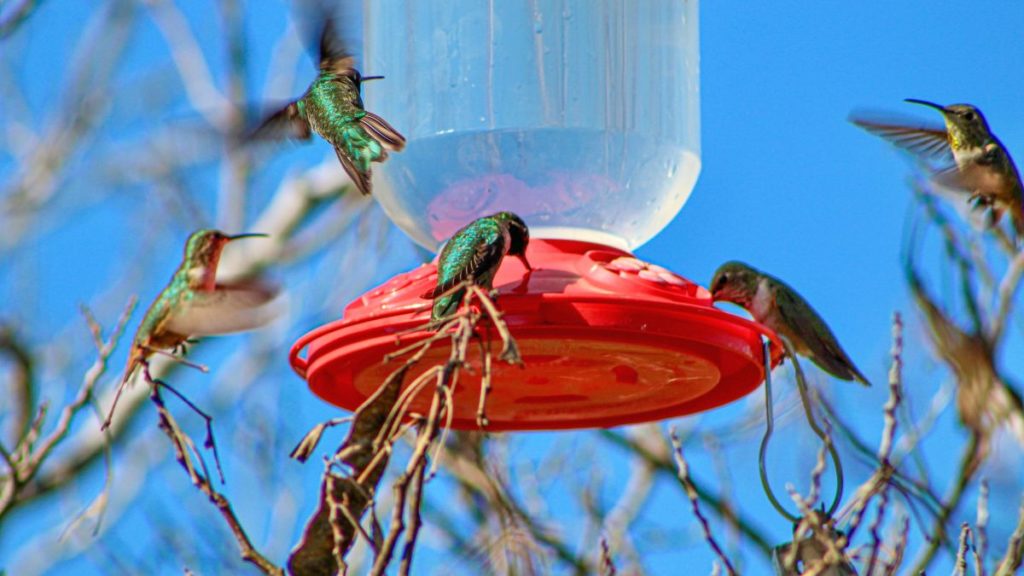
Once I hang my hummingbird feeder, I realize it is just the beginning of my relationship with the birds through the season. I have to actually maintain that feeder.
For the hummingbirds’ benefit, it is important for me to keep the food fresh and the feeder clean. My reward will be having hummingbirds in and out of my yard all summer long.
What Is The Best Food For Hummingbirds?
For me, simple is certainly the best. Use a mixture of one (1) part white sugar dissolved into four (4) parts water, boiled until the sugar is dissolved. There are commercially prepared concentrates but many of those have red dye and have additives to keep it from spoiling, both of which are not good for the birds. Remember that what is provided in the hummingbird feeder is a supplement to the foraging they will do for plant nectar, spiders, and insects.
Making your own hummingbird food is the most economical option. It ensures you are providing them the freshest mixture without unnecessary additives. I enjoy it because just like making dinner for the family or feeding my dog, I feel more connected and more supportive of these amazing birds that choose to come into my yard.
My recipe for a small batch of hummingbird food:
- Putting ¼ cup sugar and 1 cup water into a saucepan
- Stir it a little and bring the mixture to a boil
- Stir periodically until the sugar is dissolved
- Let the mixture cool completely before using.
That’s it! You have dissolved the sugar and sterilized the water through boiling.
When my schedule gets busy, it is easy enough to make a larger batch by using a full cup sugar and four (4) cups of water. I place any extra sugar water goes into an airtight container in the refrigerator. This will keep for up to two weeks and makes refilling the feeder much quicker.
Use Only Sugar In Your Hummingbird Feeder
It is important you use only white granulated sugar. Never use honey, raw sugar, brown sugar, powdered sugar, soda, etc. in your feeder. While alternative or “healthier” sweeteners are options that might be good for humans, this is not the case with hummingbirds.
They metabolize sugar differently than humans and do much better with higher or pure levels of sucrose. Alternative sweeteners may not be fully refined and may not be pure sucrose which is safe for hummingbirds.
If you want to go all in making the best hummingbird food possible, you can also consider the water you use. Tap water from a city supply may have chlorine or other additive or impurities in it. To counter this, you can measure out the water for the recipe and let it sit on the counter for a day to allow chlorine to evaporate.
How Often Should You Change Hummingbird Food?
Changing the food in your feeder may depend on the weather and where you hang it. If the weather is hot or if you hang the feeder in full sun, you will need to empty and refill the food every day or two. In milder weather or when in shadier places, you can change it every three to four days.
It is important to adhere to this schedule even if there is still food left in the feeder. I recommend checking to be sure you don’t have any mold growing or ants floating inside. I speak from experience on the latter point. More on that later.
If you find the number of birds at your feeder slows, or you are throwing out a lot of unconsumed food, you can refill the feeder halfway. Just monitor the level so that if you become the most popular restaurant in town you can refill it before it goes dry. Remember, you can keep extra hummingbird food in the refrigerator making refills easier when you don’t have time to cook up a new batch.
How Often Should You Clean a Hummingbird Feeder?
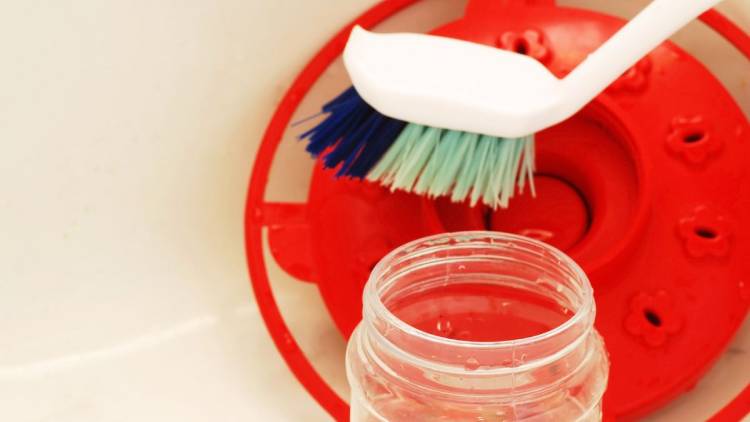
At a minimum, hummingbird feeders should be brought in and cleaned once each week. When weather is hot, you may need to empty and clean the feeder more often. If you find the feeder empty and need to refill it, take that opportunity to also give it a thorough cleaning.
What Do I Use to Clean My Hummingbird Feeder?
First, I soak my feeder in warm to hot water for about 30 minutes to help soften and remove sticky residue, bird droppings, and other debris. To wash it, I mix up a weak solution of white distilled vinegar and warm water.
My version of a weak solution is about a ¼ cup of vinegar into the amount of water that just covers the parts. I give everything a gentle scrub, inside and out, using an old toothbrush and bottle brush I’ve dedicated to the task. Lastly, I thoroughly rinse all feeder parts before refilling.
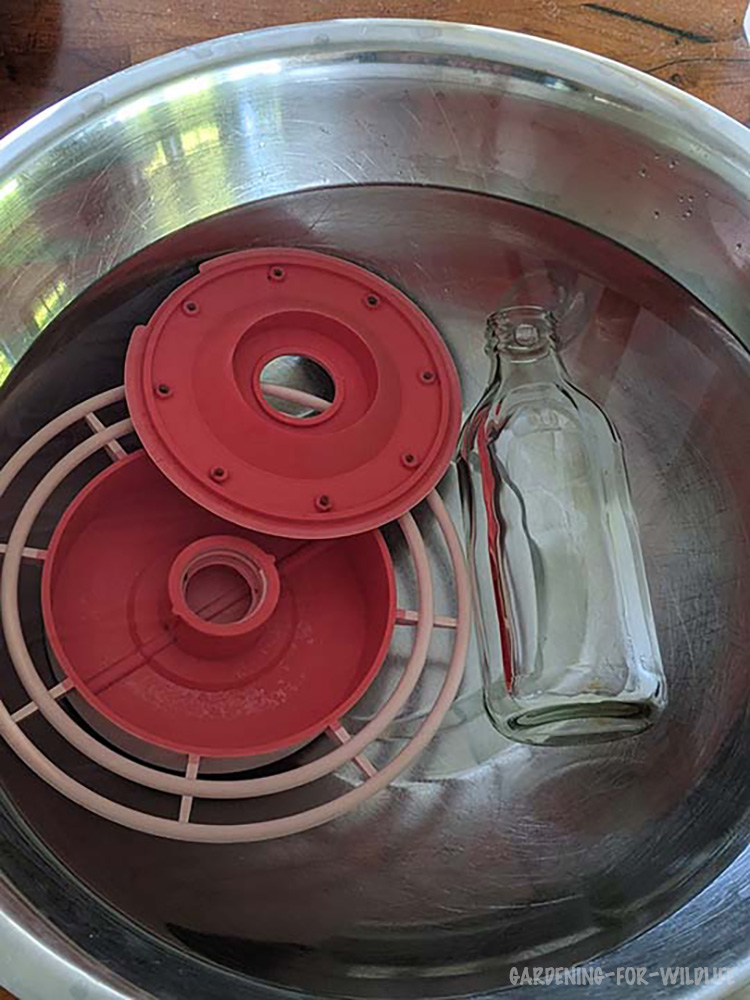
If you just don’t feel you are getting your feeder clean enough with vinegar and water, you can use a small amount of very gentle soap. Importantly though, be sure to thoroughly rinse and dry your feeder before refilling. Some dish soaps can leave residues that you want to remove before refilling.
Choose Your Feeder Through the Lens of Upkeep
If you find yourself wondering what type of feeder hummingbirds prefer, the best answer to the question is actually which feeder you prefer. More specifically, what type of feeder you would prefer to disassemble, clean, and refill frequently. Hummingbirds aren’t that picky and if you keep a feeder clean and stocked with fresh food, the style of feeder won’t really matter.
I use two hummingbird feeders. One is a small glass bottle that is screwed into a base and flipped upside down, hanging from a band around the bottle. The other is saucer-shaped feeder in which the lid snaps on the base.
- NECTAR CAPACITY: Holds 10 fluid ounces of hummingbird nectar
- FEEDING PORTS: Features four flower-shaped feeding ports to accommodate multiple hummingbirds
I prefer the look of the glass one but it is easier to clean the saucer-shape. It really comes down to personal preference as to what you want to look at and maintain. Hang the feeder in the right place and it won’t take long for the birds to find it.
When Hummingbird Feeders Attract More than Hummingbirds
Putting a sweet treat out in the yard for hummingbirds will, at some point, likely attract other animals. Other visitors to your hummingbird feeder, depending on where you live and the local fauna, might include bears, insects, and other birds such as orioles and chickadees.
In some cases, there are ways to discourage their presence. Other times, you may need to remove the feeder for a little while until the unwanted visitors move on. Don’t worry, your hummingbirds have many natural sources for food and will come back when you rehang your feeders.
How to Keep Bees and Wasps Away from Your Feeder
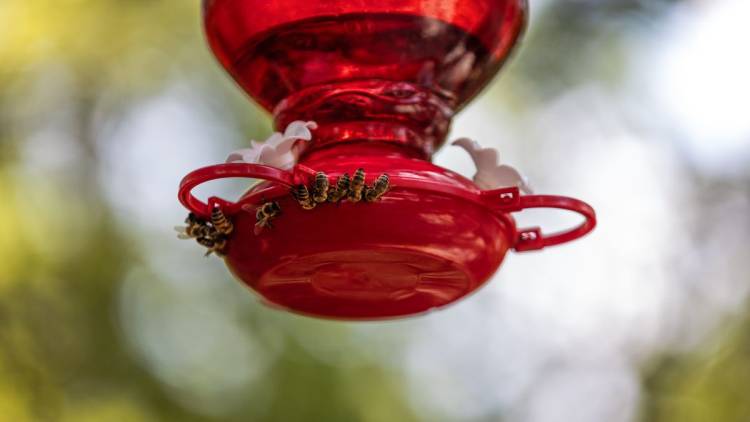
The occasional bee or wasp at your feeder is, frankly, unavoidable. Normally, they are attracted to drips and little seeps of the sugar solution. Keeping the feeder clean is really your best line of defense here.
I’ll also put a word in here for checking the condition of your feeder. Plastic parts can, over time, crack due to age and exposure over the years to sunlight. The parts of your feeder that are glass are not immune to cracks if it has been blown down or knocked about. Each time you bring your hummingbird feeder in to clean it, give it a once over inspection.
If the goal is to minimize leaks, then understanding why those leaks occur can help. The design of the feeder has a lot to do with that. The inverted bottle feeder I have relies on gravity and pressure to supply the food through the ports. Hot days can make the air inside the bottle expand and push out a bit of liquid.
On a windy day, the feeders can get blown around which can also result in more leaks. If I’ve just refilled the feeder, I’ll try to wipe it clean while hanging. If it is close to empty, I’ll just clean it and rehang it once the wind has calmed down. It might seem like a lot of work but I just consider it part of the zen of hummingbird feeder maintenance.
The saucer-shaped feeder I have seems to attract fewer bees. With this feeder, the liquid is poured into the bottom chamber and sits below the level of the port openings. Accessing the food is no problem for hummingbirds with long tongues. However, bees and wasps are out of luck there and likely only land on this feeder when there has been some slurping or dripping going on.
- Easy Clean and Fill: With round and flat dish design, this wide -mouth saucer hummingbird feeders is easy to clean and fill, just lift off the red cover to fill nectar or water. The bottom is clear enough to monitor levels and cleanliness.
- Attract Humming birds Easily: The whole top cover of the feeder have adequate red color to be attractive to the hummingbird even from a distance.
So, a few bees or wasps here and there shouldn’t be too alarming. A swarm, however, is a different matter. It is possible this is occurring due to dry weather when water sources are minimal or if there is a lack of blooming flowers.
Maintaining a bird bath or having a water source might make a difference. Growing a variety of plants that bloom at different times of the season might also be the easier alternative they need. Swarms are, normally, on the move so putting the feeder away for a few days or a week might be the best option.
Please do not use pesticides or sprays on or near your feeders. Bees and wasps are a healthy part of the ecosystem. Bees are vital pollinators for the flowers hummingbirds seek out as well as being the backbone of much of human agriculture. Wasps can be predatory on garden pests and contribute to a healthy balance in your yard and garden.
When Ants Find Your Hummingbird Feeder
For me, ants have been the biggest nuisance. Despite hanging my feeder on a tall shepherd’s hook, ants have had no problem finding their way in. Even my attempts to keep it clean fell short as I routinely found them not just on the feeder but floating inside.
Deterrents such as sticky stuff on the very bottom of the pole and diatomaceous earth around the base of the pole have had limited success. I recently purchased an ant moat and so far, I’m impressed. The strategy is to use a cup in line with the hanging of the feeder. Water in the cup is meant to be an impassable barrier for the ants.
- Extra large - the extra large cup can hold more liquid than most other products on the market, allowing you to reduce the filling frequency in hot summer.
- Strong load bearing capacity: the hook can bear the weight of 30 pounds, the middle cup is 2.36 "diameter x 1.57" height. The hummingbird feeder an.t moat can hold 100ml/1.5 oz of liquid. The whole hook is 6.2 "long.
- [LARGE 20 FL OZ CAPACITY - ONLY HUMMINGBIRDS FEED & 100% NON DRIP] – The unique feeding port design and double moat technology prevents others from accessing the nectar letting only your hummingbirds enjoy the nectar. New seal design means no more dripping and no more unwanted buzzing!
- [EASY TO OPEN AND NOW 100% NON DRIP - KEEPS NECTAR FRESHER FOR LONGER & ATTRACTS HUMMINGBIRDS] – The beautiful Natural Tulip shape sun Shade / weather guard protects birds and nectar from all weathers, meaning the nectar will not spoil and last for longer. The tulip shaped shade also keeps other unwanted birds from landing and messing on the feeder – so no more unwanted droppings or debris on your hummingbird feeder!
So far, mine is working though I could see a gang of ants manage to clump up enough to cross it. The ant moat I bought is a larger size and I’m only using water in it. This is recommended since some birds might opportunistically see it as a source of water.

I’ve seen small ant moats advertised with the suggestion of wiping the inside with mineral oil as a deterrent though that is discouraged. Substances like mineral oil shouldn’t be near where the hummingbirds feed as they can be harmful. Water is your best bet.
Because ants have been such a problem for me, I looked for another line of defense to combine with my ant moat. There is research to suggest that particular plant essential oils can act as ant deterrents. I can’t report any personal findings of my own yet, but I plan to test with a few dots of oil at the base of my shepherd’s hook near the ground.
Do Bears Bother Hummingbird Feeders?
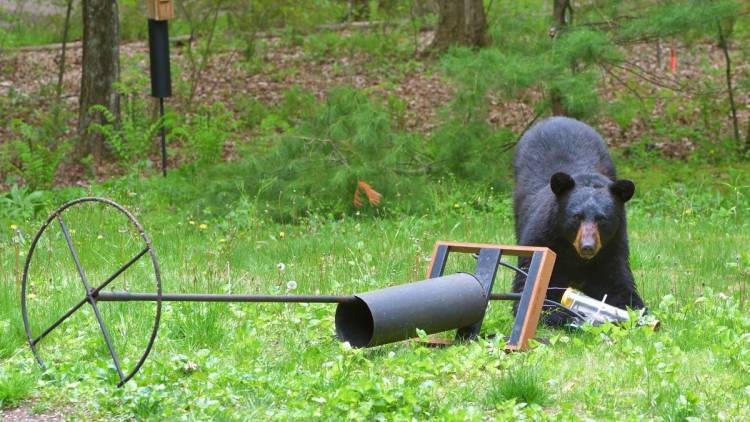
If you live in an area like my in-laws, then that answer may be yes. Their home is in a neighborhood where homes occupy acre or more lots and there are lots of woods and hills. Bears can be a common sight and more than once they have found their feeders, hummingbird and otherwise, on the ground in the morning.
Initially, the solution was to bring the feeder in at night. This worked for several weeks until a bear lumbered into their yard during daylight hours and had his way with their hummingbird feeder. Ultimately, they removed the hummingbird feeder for a month after which time they rehung it and had no further problems. Hummingbirds returned because they were still in the area, feeding on nearby flowers.
Some enthusiasts try to hang the feeders up high, but remember, bears can climb. This would also mean you will be climbing, too, since you will need to access the feeder for refilling and cleaning.
Maintain a Hummingbird Feeder Wrap Up
Personally, I think of my choice to feed hummingbirds as part of my larger commitment to do what I can to help these birds thrive. And at the risk of being corny, I feel it is a small, positive step both here and abroad where hummingbirds are a piece of the larger environmental puzzle.
So, for me, the time it takes to maintain a hummingbird feeder, make the food, keep my feeder clean and freshly filled, and work to deter and/or accept the things I cannot change (this means you, Mr. Wasp) are simply part of that commitment. And let’s face it. There is nothing like the thrill of seeing and hearing a hummingbird zoom in, hover for a snack you’ve provided, and go on about their way.




